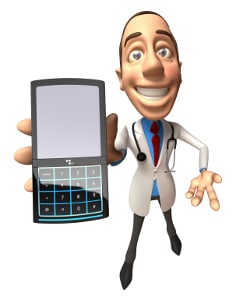 September 2, 2013
September 2, 2013
The Promise Of mHealth
By Michael D. Shaw
A 2011 NIH Consensus Group defined “mHealth” as the use of mobile and wireless devices to improve health outcomes, health care services, and health research. This article will examine some interesting areas, but first…
Lest we forget, the Feds are into controlling health care in a big way. As such, it is noted that mHealth provides virtually limitless opportunities for regulatory involvement. Purists might object that by beginning with this, I am letting the tail wag the dog. But, in case you haven’t noticed, these days, the tail IS wagging the dog in health care.
If a mobile medical app transforms a mobile platform into a medical device, or even an accessory that interprets data from a medical device, it would be regulated by the FDA. The FCC is already involved with phones, of course, but now that certain medical devices transmit wirelessly, they could also be regulated by that agency.
The FTC, under authority of the Federal Trade Commission Act of 1914—and in a possible turf battle with the FDA—would be on the hunt for false and misleading advertising claims. Reimbursements for mHealth products would be controlled by the Center for Medicare & Medicaid Services (CMS). As readers of this column know, although CMS’ authority theoretically covers only those services described in the agency’s name, all private insurance carriers emulate CMS policies.
Matters of privacy and security of mHealth (HIPAA) would be handled by HHS’ Office for Civil Rights. Finally, the National Institute of Standards and Technology (NIST) coordinates matters relating to the certification of electronic health records (EHRs). Enough acronyms for you?
The FCC, capitalizing on the fact that wireless communications are at the very heart of mHealth, has assumed a leadership role of sorts. Last summer, the agency assembled a task force that released a widely-publicized report of findings and recommendations. At the outset, the report reminds us that “Health care delivery is at a critical juncture in the U.S. both in terms of quality and cost. The U.S. ranks 37th in the world for health care system performance, yet spends more on health care per capita and more on health care as percentage of its GDP than any other nation.” And, what’s the good news?
“mHealth can improve patient care and create cost savings by capturing information for providers and allow them to rapidly analyze large amounts of information to better understand a person’s health trends over time. mHealth also offers the promise of giving patients easier access to their health information, and it allows the mining of data to improve cost transparency, increasing efficiencies across the continuum of care, and enabling more accurate diagnosis and treatment.”
Some interesting examples of mHealth include:
- Medical devices that act as remote patient monitors used in clinical, home, and other environments.
- Medical body area network sensors that capture and transmit physiological data for further analysis.
- Medical implant devices that allow neuromuscular microstimulation techniques to restore sensation, mobility, and other functions to paralyzed limbs and organs.
- Mobile diagnostic imaging applications that allow doctors to send or review medical images from virtually any place, and at any time.
- Accessible clinical decision support tools that allow doctors to help patients in real time with diagnosis, treatment options, and necessary medical calculations at the point of care.
And, here’s one you may not have thought of—mobile management of a field service force, as exemplified by Digital Dispatcher, based in Jenkintown, PA. Listen to Bill Stomp, V.P. Business Development:
Digital Dispatcher represents the next stage of empowering a mobile workforce, in which managers can monitor their in-the-field or on-the-job employees with absolute precision. While our resources are currently quite popular within the propane delivery and HVAC industry, where fleets of service trucks make several stops throughout the course of a given day, they are just as applicable and valuable to health care.
A hospital or medical practice, by giving their employees nothing more than a smartphone, can observe—from their desktop computer—how many visits a provider makes, the average duration spent with each patient, the rapidity (and route) by which an ambulance driver makes it to the Emergency Room, as well as how productive each worker is. This intelligence translates into identifiable savings—with improved quality—and better communication among all parties.
The hope and promise of mHealth is that it can help rehabilitate health care…and quickly.
